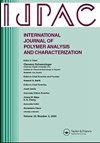Influence of structural disorder on the elastic, frictional, and electrical properties in functionalized polyaniline thin films at the nanoscale investigated by atomic force microscopy
IF 1.7
4区 工程技术
Q4 POLYMER SCIENCE
International Journal of Polymer Analysis and Characterization
Pub Date : 2023-01-01
DOI:10.1080/1023666X.2023.2242638
引用次数: 0
Abstract
We investigated the influence of structural order on the elastic, frictional, and electrical properties of butylthio-functionalized PANI (PANI-SBu) films by atomic force microscopy (AFM)-based techniques, including PeakForce quantitative nanomechanical mapping, friction force microscopy, and conductive AFM. The PANI-SBu films were prepared by the drop-cast method from the solution of PANI-SBu in N-methyl-2-pyrrolidone that was continuously stirred. The PANI-SBu films were fabricated after different solution stirring times. The shear force during the mechanical stir will disentangle the highly-coiled PANI-SBu polymer chains in the solution. Therefore, the polymer chains in solution cast on the substrates will progressively self-assemble into a more organized structure when solvents evaporate, leading to PANI-SBu films with improved structural order. Our AFM studies discovered that more structurally-ordered PANI-SBu films have substantially larger out-of-plane elastic moduli and charge mobility but smaller kinetic friction coefficients. The denser packing of polymer molecules increases film elasticities and promotes chain-to-chain charge transport. In addition, stiffer PANI-SBu film surfaces are more difficult to deform when sheared by the sliding AFM probe, resulting in less energy dissipation during AFM friction measurements. Thus, smaller kinetic friction coefficients were found. Conversely, more structurally-disordered PANI-SBu films have smaller elasticity and charge mobility but larger kinetic friction coefficients. Our results demonstrate that it is possible to manipulate the elastic, frictional, and electrical properties of PANI-SBu films by controlling their structural order, which can be essential for developing polymer-based composite materials and flexible electronic devices.
原子力显微镜研究了结构无序对纳米级功能化聚苯胺薄膜弹性、摩擦和电学性能的影响
摘要:采用基于原子力显微镜(AFM)的技术,包括PeakForce定量纳米力学图、摩擦力显微镜和导电AFM,研究了结构顺序对丁基硫基功能化聚苯胺(PANI- sbu)薄膜弹性、摩擦和电性能的影响。在n -甲基-2-吡咯烷酮溶液中连续搅拌,采用滴铸法制备了聚苯胺- sbu膜。通过不同的溶液搅拌时间制备聚苯胺- sbu薄膜。机械搅拌过程中的剪切力会使溶液中高度盘绕的聚苯胺- sbu聚合物链解开。因此,当溶剂蒸发时,浇铸在衬底上的溶液中的聚合物链会逐渐自组装成更有组织的结构,从而得到结构有序的PANI-SBu薄膜。我们的AFM研究发现,结构有序的pan - sbu薄膜具有更大的面外弹性模量和电荷迁移率,但动摩擦系数较小。聚合物分子的致密性增加了薄膜的弹性,促进了链到链的电荷传递。此外,更硬的PANI-SBu薄膜表面在被滑动AFM探针剪切时更难以变形,从而导致AFM摩擦测量时的能量耗散更少。因此,发现较小的动摩擦系数。相反,结构越无序的PANI-SBu薄膜弹性和电荷迁移率越小,动摩擦系数越大。我们的研究结果表明,可以通过控制其结构顺序来操纵聚苯胺- sbu薄膜的弹性、摩擦和电学性能,这对于开发聚合物基复合材料和柔性电子器件至关重要。
本文章由计算机程序翻译,如有差异,请以英文原文为准。
求助全文
约1分钟内获得全文
求助全文
来源期刊
CiteScore
3.50
自引率
5.30%
发文量
37
审稿时长
1.6 months
期刊介绍:
The scope of the journal is to publish original contributions and reviews on studies, methodologies, instrumentation, and applications involving the analysis and characterization of polymers and polymeric-based materials, including synthetic polymers, blends, composites, fibers, coatings, supramolecular structures, polysaccharides, and biopolymers. The Journal will accept papers and review articles on the following topics and research areas involving fundamental and applied studies of polymer analysis and characterization:
Characterization and analysis of new and existing polymers and polymeric-based materials.
Design and evaluation of analytical instrumentation and physical testing equipment.
Determination of molecular weight, size, conformation, branching, cross-linking, chemical structure, and sequence distribution.
Using separation, spectroscopic, and scattering techniques.
Surface characterization of polymeric materials.
Measurement of solution and bulk properties and behavior of polymers.
Studies involving structure-property-processing relationships, and polymer aging.
Analysis of oligomeric materials.
Analysis of polymer additives and decomposition products.

 求助内容:
求助内容: 应助结果提醒方式:
应助结果提醒方式:


